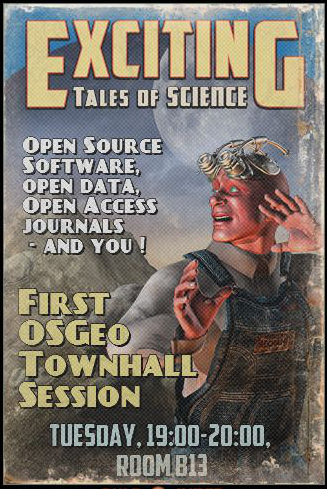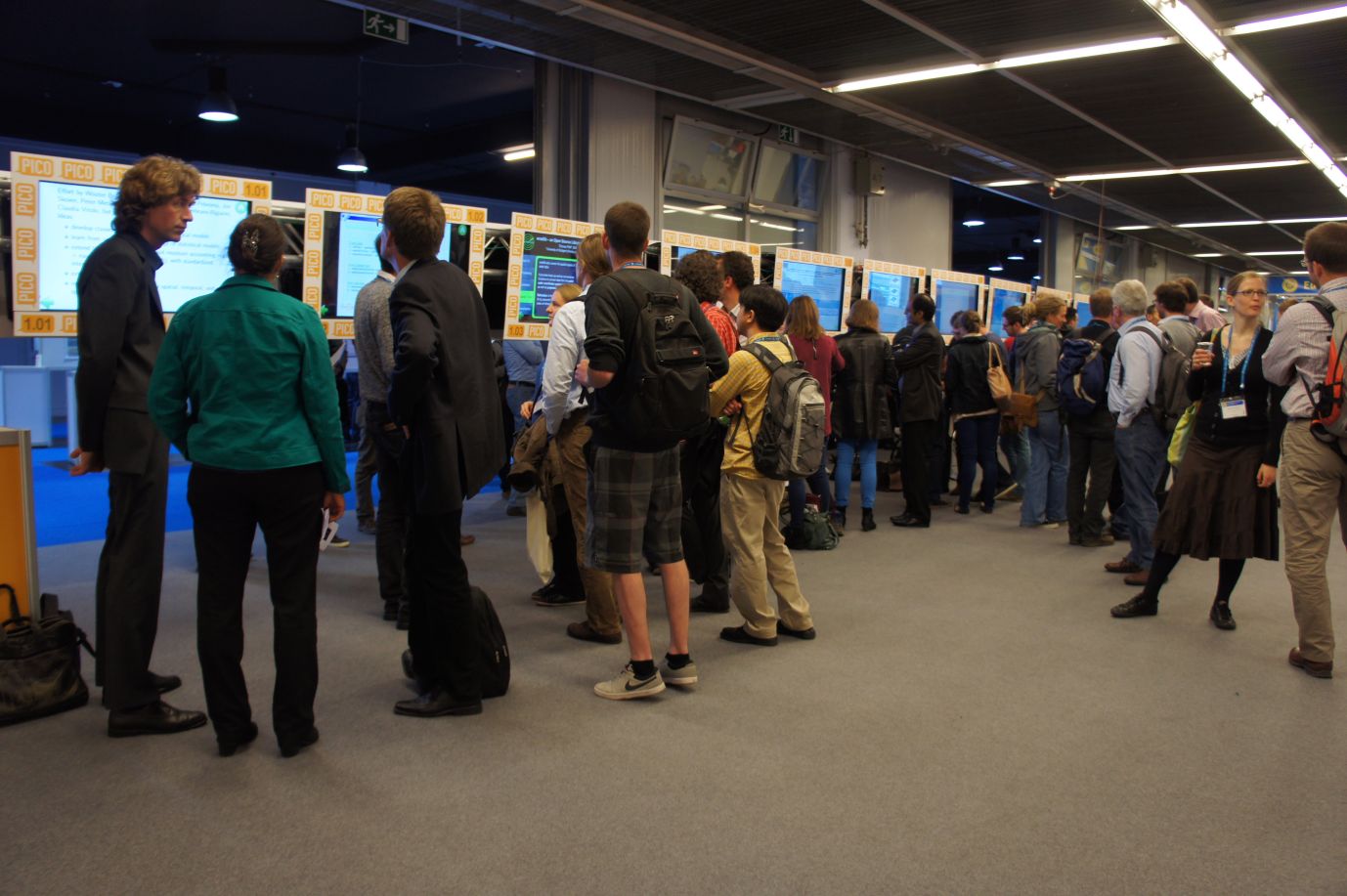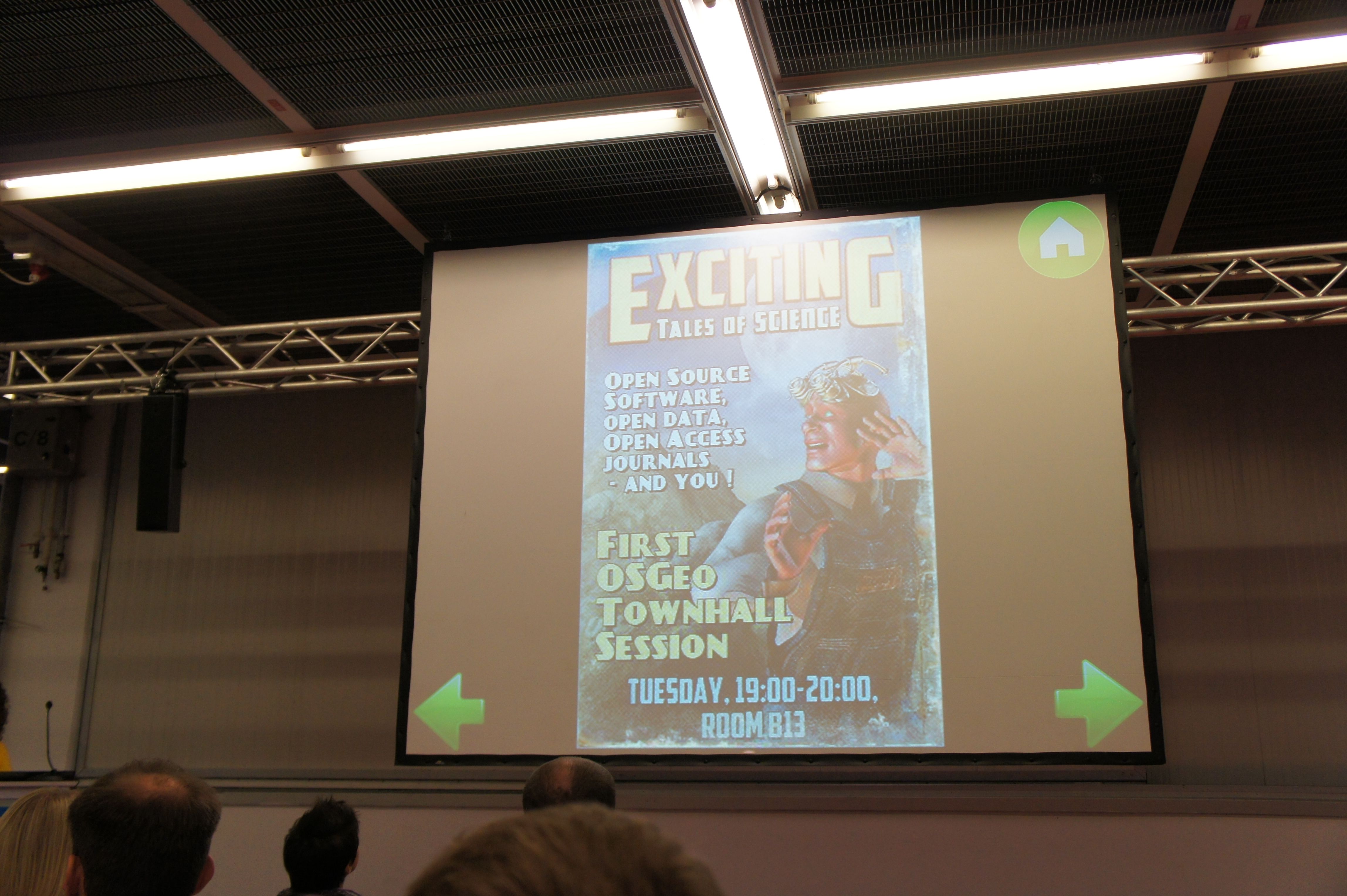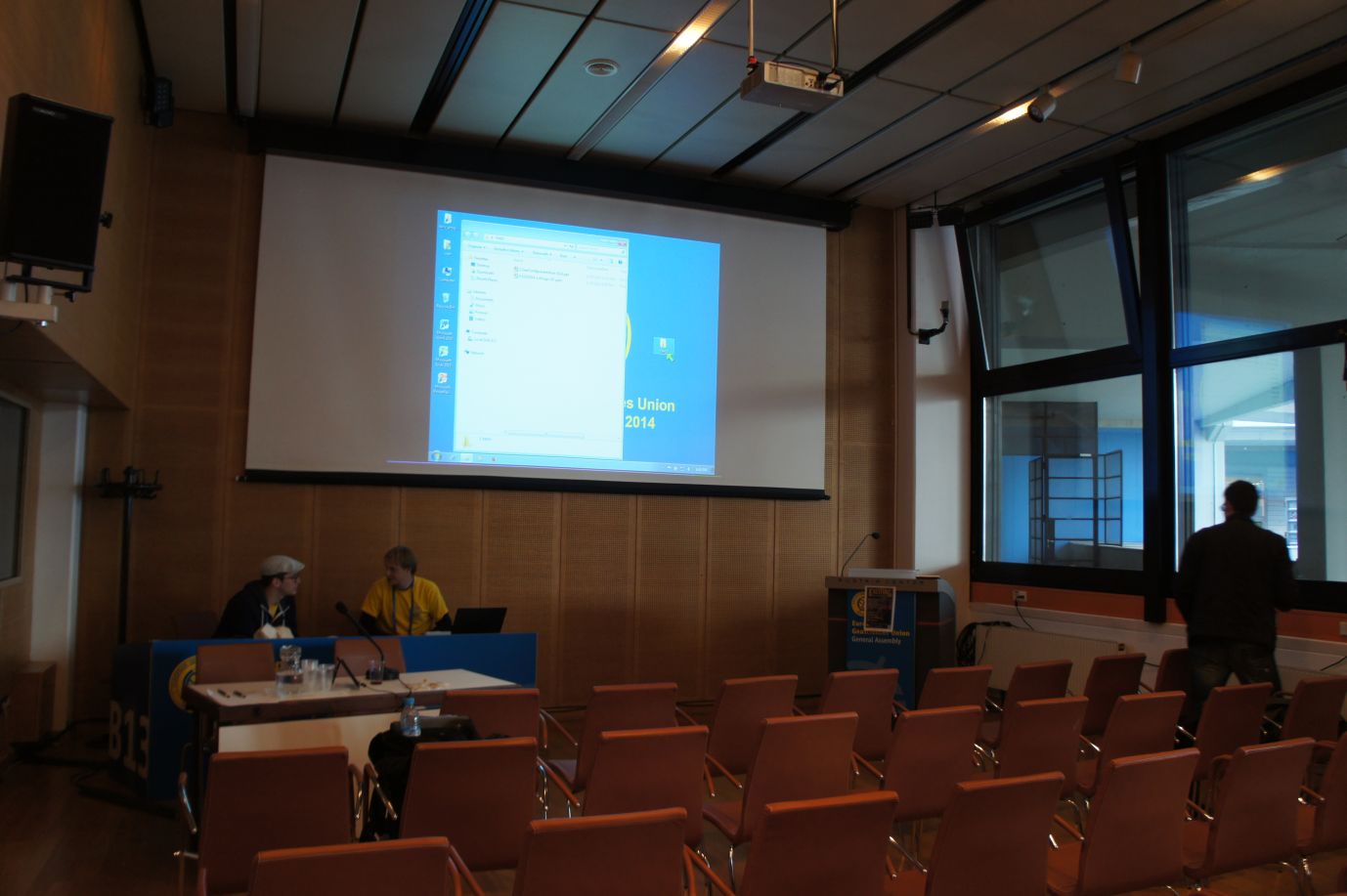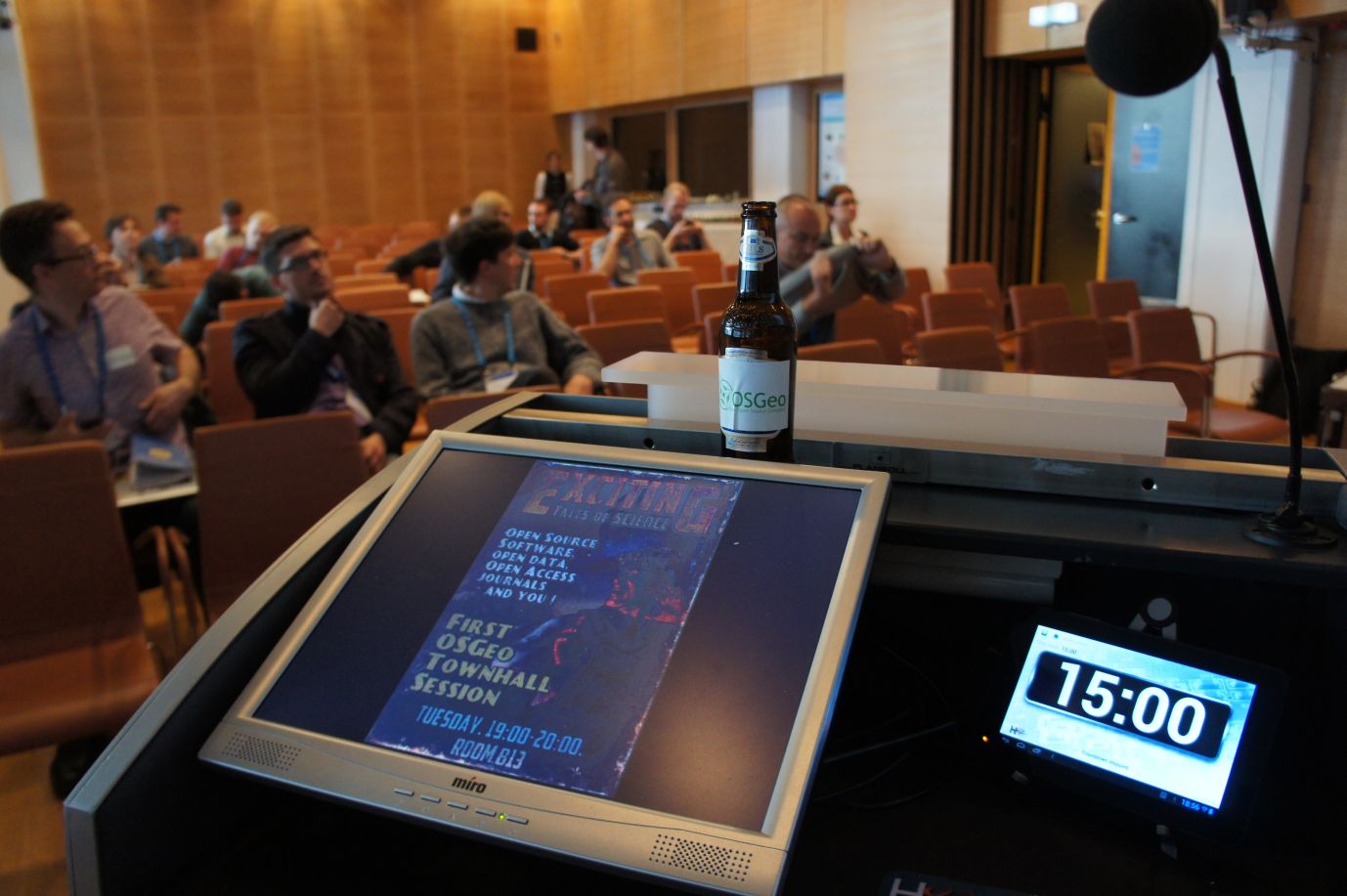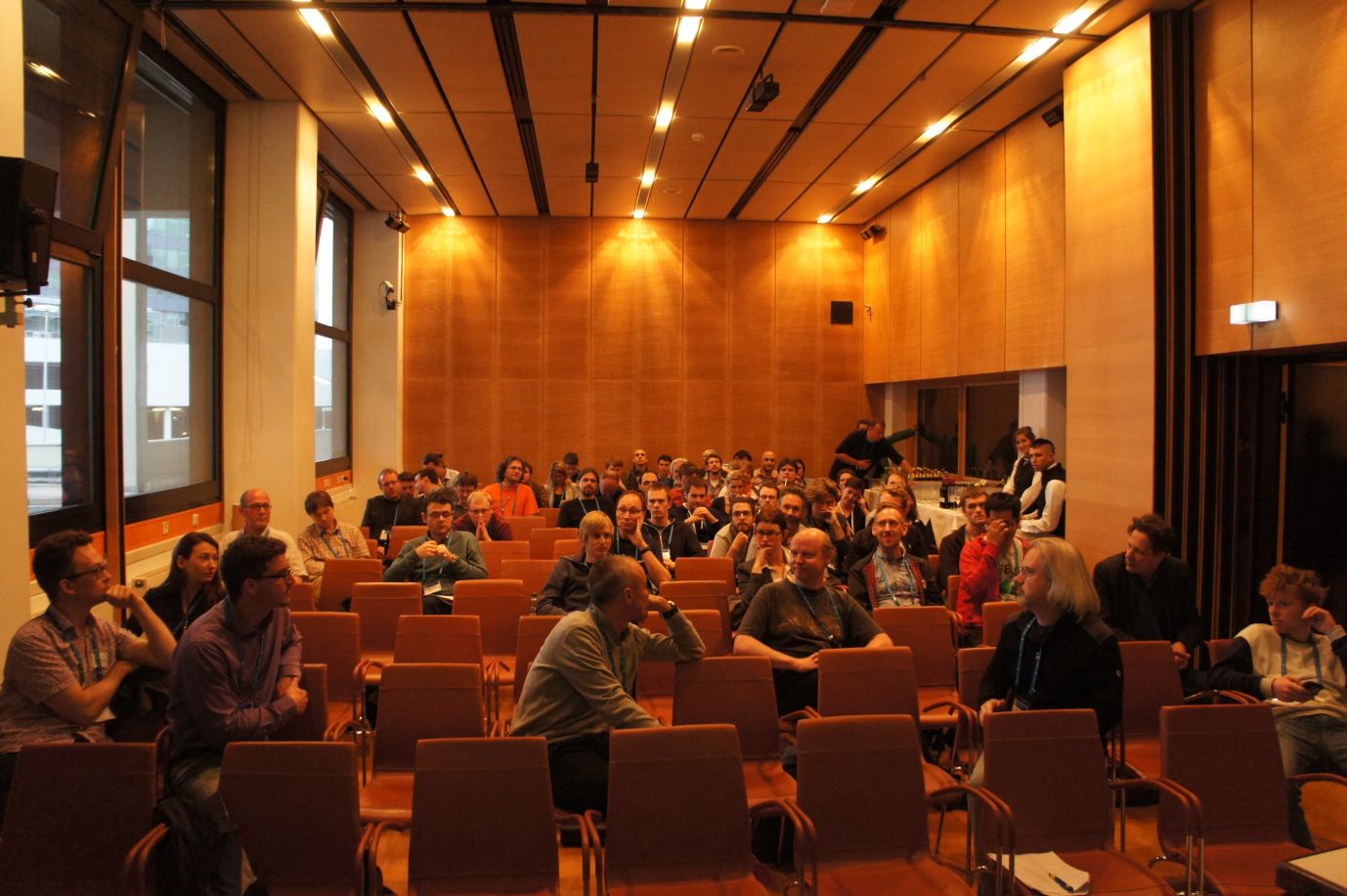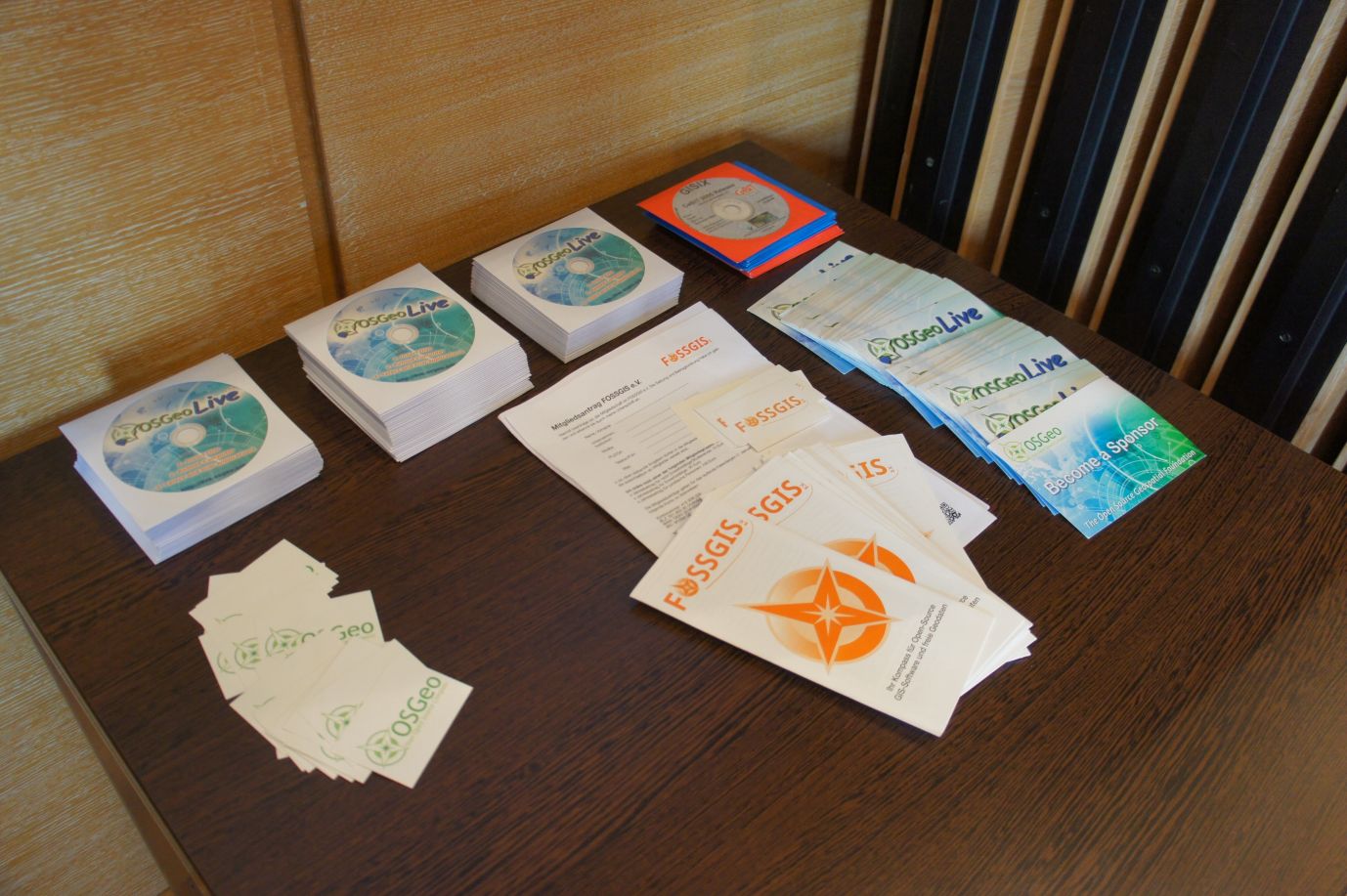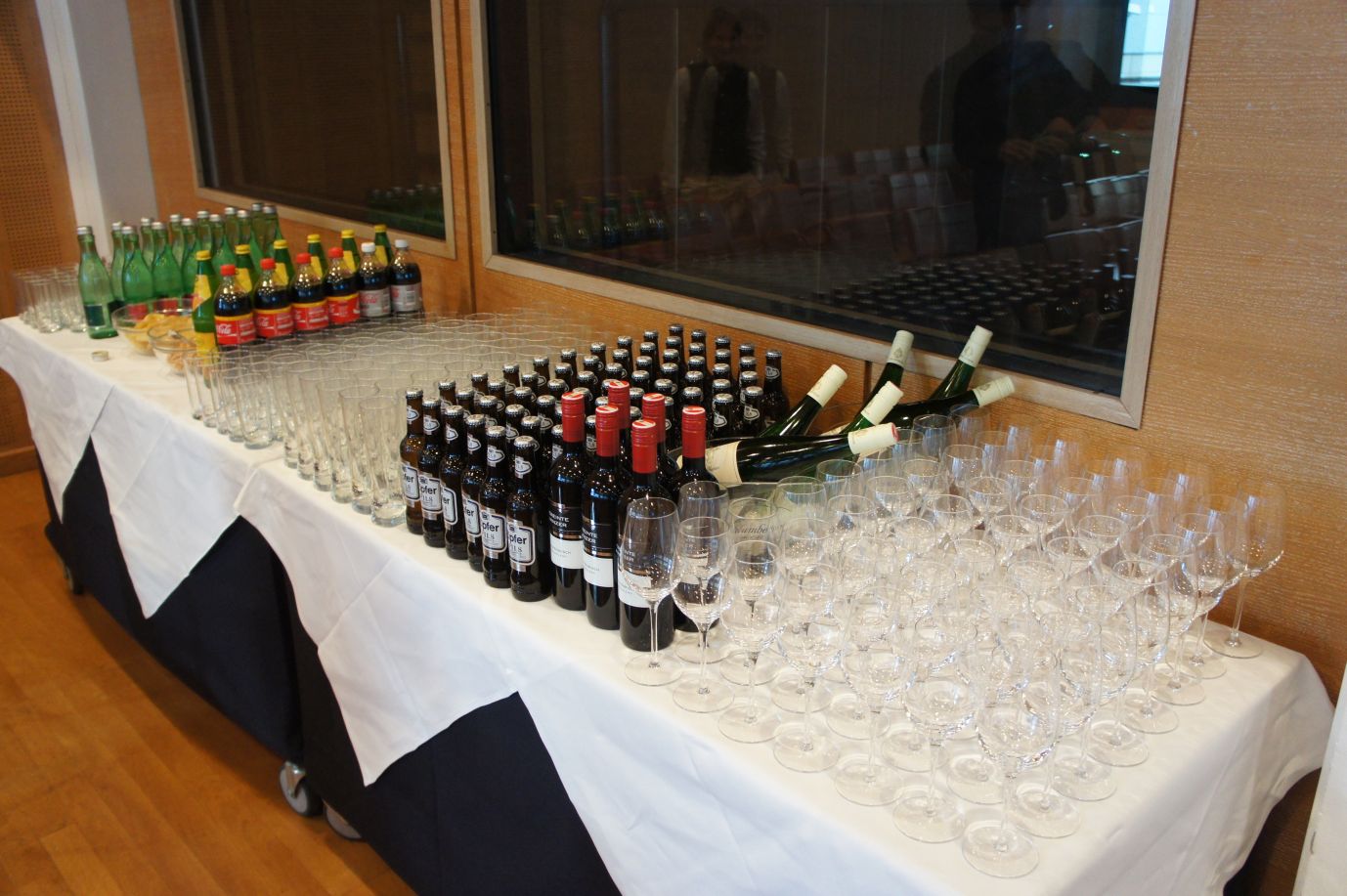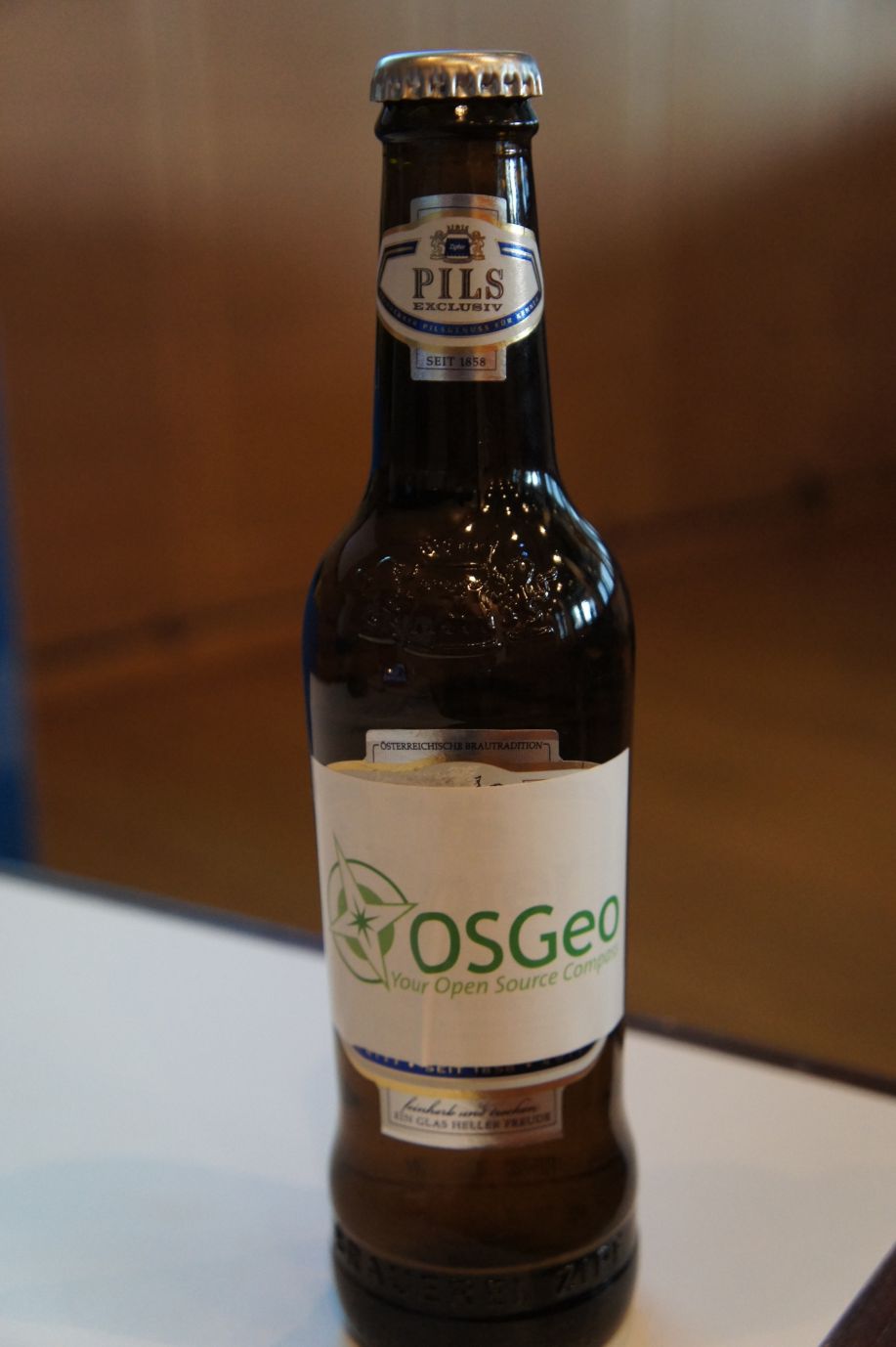EGU Townhall 2014
First OSGeo Townhall at EGU 2014
Held at the European Geoscience Union (EGU) General Assembly 2014 (April 29, 2014).
Executive Summary
This is a report on the OSGeo EGU townhall 2014 project.
The aim of the project was to raise awareness at and reach-out to the European geoscience community by hosting a dedicated public OSGeo event at the largest European geoscience conference.
The project was a success. All goals were reached.
This report details preparation, execution, aftermath and lessons learned.
Background Info
What is the European Geoscience Union (EGU)?
The European Geosciences Union (EGU) is dedicated to the pursuit of excellence in the geosciences and the planetary and space sciences for the benefit of humanity, worldwide. It was established in September 2002. It is a non-profit international union of scientists with over 12,500 members from all over the world. Membership is open to individuals who are professionally engaged in or associated with geosciences and planetary and space sciences and related studies, including students and retired seniors. EGU is organised in so called divisions (22), which have specific thematic foci within geosciences.
What is an EGU General Assembly ?
The annual EGU General Assembly (GA) is the largest and most prominent European geosciences event. This years GA attracted over 12,000 scientists from all over the world, of which more than a quarter are students. The meeting’s sessions, typically over 500, cover a wide range of topics. General Assemblies have around 14,000 submissions (oral presentations and posters). Aside from disciplinary sessions, dealing with the topics covered by each scientific division, the meeting also features Union-wide sessions, including townhall meetings. In 2014 there were 13 such townhall meetings.
Townhall Meeting are official EGU meetings, open for all participants in the conference. During these meetings new initiatives or decisions are announced to a larger audience following an open discussion on the matter. Townhall Meetings last 60 minutes in the evening and take place in the conference centre’s lecture rooms, fit 50 to 350 people, and are announced in the Programme (Information & Schedule Book). As they are staged in the evening after the scientific sessions, Townhalls attract large crowds.
Splinter Meetings are informal side meetings on non-commercial purposes organized by participants. They can be organized during the course of the conference and they can be public or by invitation only. Splinter Meetings last up to 90 minutes and are held during the day. Scientific sessions are held in parallel, which could prevent people potentially from attending. They fit 36 to 60 people and are announced in the Programme (Information & Schedule Book) if booked early.
FOSS GIS and the role of OSGeo affect most if not all EGU divisions, as the paradigm of good scientific practice (open data and open source for transparency) is now changing all over geoscience. Since 2012, there have been FOSS GIS themed events at the EGU General assembly. OSGeo-related activities started with an improvised splinter session (compares to Birds of a Feather (BoF) meetings) which drew a surprisingly large crowd in 2012. This was arranged by Alessandro Frigeri (Italy) and Peter Löwe (Germany). This was followed by an equally successful splinter session in 2013.
At least since 2006, references to OSGeo software projects and other FOSS tools appear in the poster sessions (> 9000 posters) every year. In 2013, the first call for a EGU session on FOSS GIS in the Earth and Space Science Informatics (ESSI) received imediately sufficient interest from the science community to conduct both both oral presentations and a posters session. In 2014 there were two dedicated FOSS sessions (ESSI and Hydrology Diviisons). This is a significant step ahead: By now, researchers can successfully apply to attend this EGU conference, to showcase the FOSS aspects of their work. Before this, everything “FOSS” had to be relabelled since no session would address the topic.
There were two reasons why to consider a genuine OSGeo event at EGU in 2014: Firstly, the role and significance of OSGeo for geoscience still needed to be introduced at a cross-cutting venue (top-down). Secondly, experience shows that FOSS is already emergent in several other EGU divisions. So an event was needed beyond the rigid EGU division structure to allow all the different FOSS stakeholders to meet (bottom-up).
Preparation/Execution
Funding
Preparation
Funding was requested from the OSGeo marketing board. The OSGeo assembly passed a move to provide a budget, approving a funding for both catering for a OSGeo townhall and the printing of DVD.
Execution
Upon the positive decision by OSGeo, a Townhall time slot was requested from EGU, catering was ordered and and order for DVD production was placed.
Lessons Learned
Since the process to have OSGeo approve funding for an event takes time, factoring in a financial buffer (5% ?) might be advisable unless the financial planning process can be sped up. This measure will prevent involved parties taking the risk of fronting own money to support the event, without being able to get reimbursed by OSGeo. In the case of EGU 2014, the costs for the last minute poster campaign of 50 EUR (68 USD, 4 % of total budget) could not be reclaimed. According to a show of hands during the event, the guerrilla/retro-science poster campaign attracted about 25% of the attendees. Quick money for such actions would be an asset.
OSGeoLive DVDs
Preparation
Since give-away items are frequently used at EGU General Assemblies, it was decided to have a batch of 100 OSGeo Live DVDs (Version 7.9) produced. Production was handled by ABC-ROXXON (www.abc-roxxon.de) in Hannover, Germany, which has a good reputation for producing OSGeo-Live-DVDs for FOSSGIS e.V. events (recommended by Astrid Emde). Production took about 1 week. The DVDs were personally picked up to avoid extra shipping costs (20EUR / 27 USD). Payment was made locally (Peter Löwe), which was reimbursed by a OSGeo money wire afterwards.
Execution
The whole batch of 100 OSGeo DVDs and additional OSGeo-Live postcards (surplus from the german FOSSGIS 2014 conference) were used up during the Townhall and the remaining FOSS-themed EGU sessions.
Lessons Learned
OSGeo-live postcards should feature a QR code pointing to the download section. Alternatively OSGeo QR-code stickers would be a nice option.
Catering
Preparation
EGU townhall events require catering, which is not covered by EGU. Therefore, OSGeo financial support was crucial to conduct the event. There is only a single catering company available for the Vienna International Conference Centre (VIC), where the EGU General Assembly is hosted. The caterer was contacted once OSGeo agreed to provide sufficient funding. It took some time to clarify that the OSGeo credit card could be used, so the order was placed only 10 days before the event. Since many very large catering events are hosted during EGU, even large townhalls (350 attendees) rank as small/medium scale events and can be arranged on relatively short notice.
Execution
Catering was delivered to the Townhall conference room in due time.
Lessons Learned
The caterer sent the printed invoice in the aftermath of the conference (Peter Loewe) and charged the amount to the OSGeo credit card. The actual cost of 1270 EUR is less than the anticipated amount of 1500 EUR.
Lessons learned/passed down from IODP (International Ocean Discovery Program)
- Don’t consider running a townhall without catering, this is against the EGU culture (and expectations of potential attendees).
- Order only minimal nibbles (pretzels, nuts). Focus on a basic set of nonalcoholic and alcoholic beverages: Water, softdrinks (coke, orange juice), beer, red wine, white wine.
- The quality of even the cheapest wines and beers available is suitable.
- Draught beer and cocktails are very cost intense.
Lessons learned during the OSGeo Townhall
- Basic costs are about 1200 EUR (set-up, staff, mandatory nibbles). If we really go for a room holding 100 people, we should up the catering budget to 1,700 EUR to avoid a cost-overrun.
- Make sure that no items are listed on the bill, which have not actually been consumed (example: coffee), the catering company might make mistakes. Photo documentation (before/after) might be usefull.
- When ordering catering for future EGU events: The Austrian order contract sheet provided by the Caterer calls for a tax-number, a proper stamp, etc. This can be omitted. Signature + handling address are required and can be written on the last page of the contract, which is to be scanned/emailed or faxed.
- Select time slot wisely and consider competing townhalls and other events (local community event, OSGeo live-Teach-in, etc.)
- Place catering order only after EGU/Copernicus(the organizers) has confirmed the size of the room. The number of confirmed seats should be the baseline for all catering. In 2014 I applied for a room holding 100 people and ordered catering accordingly. It was learned later in the process that EGU only had allotted a room for 50 people. About 70 persons attended the Townhall (wandering off, coming in). The caterer had provided (mandatory) nibbles (chips, pretzels,etc) for 100 persons, which were all charged for. A follow-up request to exclude the unused food (~ 30 servings) from the bill was declined. Such unnecessary expenses should be avoided in the future.
Advertising
Preparation
The upcoming event was actively announced in the OSGeo and EGU communities on various mailing lists, and also on social networks (FB, Linkedin). In the days before the event, a last minute marketing campaign for the OSGeo Townhall was conducted by putting up posters at AGU newsstands and booths. Experience from previous EGU (FOSS Splinter Meetings in 2012/2013) has shown that this works well, provided that the posters stand out. Because of this, a “retro/steampunk”-design was chosen (see below), which included the official OSGeo logo for easy recognition and proper branding.
Execution
A show of hands poll during the Townhall indicated that about 25% of the attendees came because of the poster campaign. Of the remaining 75% percent was divided in 25% (OSGeo communication channels) and 50% (EGU channels).
Lessons Learned
- Bring your own pins/needles to stick posters on messaging boards or come early before the available stock is used by someone else.
- Currently EGU/ESSI doesn’t provide dedicated Email groups to keep contact outside the GA events.
- A larger and integrated advertising effort for all OSGeo-related activities withing a EGU GA should be considered. Use email lists collected during previous years (2014 list is included below). Synchronize with FOSS stakeholders which are not part of OSGeo.
- Social network groups (Research Gate, Facebook, Linkedin) could also be considered for networking.
- Active guerilla marketing during the conference should be considered. Advertise during PICO sessions, oral sessions andposter sessions.
- Prepare for competition – consider other Townhals which might compete for attendees. Consider that people actively involved in EGU/AGU might have to attend other townhalls for political reasons.
- Reach out to Geo for all/ICA: Salzburg/Z-GIS is the local stakeholder in Austria. This might be useful for interfacing with the ZGIS community.
- Use collected Email lists to attract new members: Prepare a template to be printed out ahead of the event. Groups in FB, Linkedin, Researchgate should be considered.
- ORF (Austrian national radio broadcast) covered the 2013 splinter session, which resulted in a podcast. Contact local media ahead of time as a multiplier.
- Consider using the EGU press booths: Press conferences of different size can be arranged at EGU. Local point of contact: Helmut (Helli) Kudronvsky.
- Posters can be put up before the townhall. They are a good way to showcase OSgeo or OSGeo-Live. A poster visually listing all projects included in OSGeo-Live DVD distribution would be very useful.
Programme
Preparation
The programme was arranged within two weeks before the event. Since several OSGeo activists, which had been foressen as potential speakers, could not attend the conference, the schedule had to be iteratively adapted.
Execution
During the townhall, four presentations were given by Peter Löwe (What is OSGeo, why does it matter for Science/EGU, OSGeo-Live, the research library perspective), Attilio Castellarin (University Bologna, Convener of the FOSS session on Hydrology: The significance of OSGeo/FOSS for geoscientists), Jeffrey Morley (OSGeo: Geo for all) and Martin Hammitzsch (GFZ Potsdam, Sciforge Project: Open data and FOSS citation and preservation).
The presentations of Atti, Jeffrey and Martin were recorded and can be provided to OSGeo, including photo documentation.
Presentation slides
Presentation slides archived in Zenodo (citeable by DOI)
Lessons Learned
Structuring: A townhall lasts officially one hours, if the waiters are treated well (tipping: 5 EUR each, optional, not expected), the interval between “last order” and “all out” can be stretched for approx 30 minutes extra. Keep the agenda short and limit all presentations to a _total_ of 30 minutes (better: 20 minutes), to allow for discussion and refreshments (“free speech and free beer”). Start on time and be prepared for latecomers. Entertaining talks are a good idea – everybody had a long day. Open the bar early to rise spirits.
Infrastructure: Townhall rooms come with a presentation laptop (Windows OS) connected to a LCD projector. There is also a presenter-device with a laser pointer. A local EGU representative is around at least for the start of the event, helping to transfer presentations from USB sticks, etc. Laptops can be hooked up, too. It should be confirmed in advance if equipment to hook up Apple hardware is provided.
Use of posters: Scotch tape, scissors, etc should be brought to the event. The sticky poster strips provided by EGU for free in the poster halls can be used as a backup.
Audience
Preparation
The room assigned by EGU for the OSGeo Townhall seated 50 people (a room for 100 people had been initially requested). The small room size resulted most likely from multiple Townhall events with longer track record in the same time slot, which were competing for venue (and audience).
Execution
The session started with about 35-40 people and filled up until the end. Over all the event must have attracted 65++ people, as folks came and went (for other Townhalls providing fancy Cocktails, etc.). We received feedback that people actually returned after having left, as the OSGeo topic outweighed more sophisticated refreshments at other townhalls.
E-Mail addresses were collected for headcount, later analysis and to allow for future communication.
Lessons Learned
The Townhall really hit the spot: The discussion was extremely lively but couldn’t be finished due to the limited time (60 minutes). According to IODP (International Ocean Discovery Project (they’re colleagues and host large Townhalls for 350 attendees), we did very well: A 50% room fill (25 attendees) would already have been good for the “first year”. This is also an indicator for the significance of the topic @ EGU. EGU/Copernicus allots rooms for townhalls according to “merit”. Since we had a fairly full house, we could go for a larger room/audience in 2015.
Further Lessons Leearned
Additional EGU events
All aspects of FOSS in the Geosciences, as covered by OSGeo, need to be discussed within Academia/EGU/AGU on a large scale. While the first townhall was a culmination of the FOSS-related activities of the past years, a single townhall session can not accommodate all parties interested in FOSS and their particular interests. It should be considered that multiple OSGeo-related events should be planned for: If possible, similar events should be staged in the future to attract young scientists and foster the networking between OSGeo, AGU and the scientific community. However, the topic can not be addressed in full depth within a 60 Minute meet&greet event.
- Education event: OSGeo-live demonstration
- OSGeo Session in science communication
- Meet & greet with local Austrian OSGeo community: Helli organized a great event of this kind in the Prater amusement park in 2013.
- Local workshop (Hackfest ?) on the post-EGU weekend ?
- Teach-in @ Uni Vienna ?
Experience shows that cross cutting topics such as FOSS are only partially covered in the current EGU Division and session structure. A dialogue with EGU was begun to address this.
Dedicated OSGeo-Live Event
A dedicated EGU-event should be considered to better cover OSGeo-Live. The 2014 townhall just allowed to introduce the topic and disseminate DVDs and postcards. During the limited amount of time only a "best of"-selection from Cameron's OSGeo- Live-slides was presented.
Promotional Material
Poster
Photo coverage
Promotion during EGU
